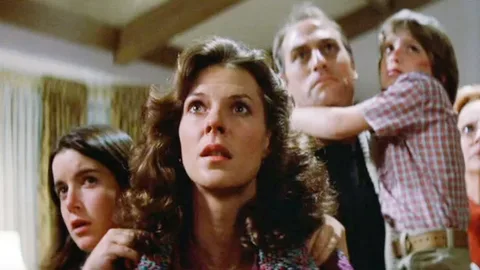Introduction to the Controversy
Step into the eerie world of 1982’s cult classic, “Poltergeist,” where the supernatural meets real-life controversy. Dive deep into the spine-chilling tale that shocked audiences for more than its paranormal scares. Discover the unsettling truth behind why this iconic horror flick used real skeletons to bring terror to the big screen. Get ready to unravel a bone-chilling mystery that will make you question what lurks beyond our realm of existence in Hollywood’s dark underbelly.
Background of the Movie

The 1982 movie “Poltergeist” is a classic horror film that has captivated audiences for decades. Directed by Tobe Hooper and produced by Steven Spielberg, the movie follows the Freeling family as they are haunted by malevolent spirits in their suburban home.
With its groundbreaking special effects and chilling storyline, “Poltergeist” quickly became a cult favourite among horror enthusiasts. The film’s success can be attributed to its innovative approach to supernatural themes and impressive performances from its cast.
Featuring iconic scenes like the infamous TV static disturbance and the eerie clown doll attack, “Poltergeist” set new standards for horror filmmaking in the early 1980s. Its blend of terror, suspense, and emotional depth resonated with audiences worldwide, solidifying its place in cinematic history.
As one of the most influential horror films of its time, “Poltergeist” continues to be celebrated for its groundbreaking visuals and spine-tingling scares.
How and Why Real Skeletons Were Used in the Film
In the making of the 1982 movie Poltergeist, a decision was made to use real skeletons during one particular scene. The choice to incorporate authentic human remains added an unsettling realism to the film’s eerie atmosphere.
The production team sourced these skeletons from medical suppliers due to their cost efficiency and realistic appearance on camera. However, this decision sparked controversy among both cast members and the public.
Despite industry standards at that time, using real skeletons raised ethical concerns regarding respect for the deceased and proper handling of human remains in a fictional setting. This practice highlighted a blurred line between artistic authenticity and moral considerations within filmmaking.
The use of real skeletons in Poltergeist opened up discussions about ethical boundaries in cinema and prompted changes in industry regulations moving forward.
Public Reaction and Criticism
When the public learned about the use of real skeletons in the 1982 movie Poltergeist, shock and outrage rippled through audiences. The idea that human remains were used as props in a Hollywood production was unsettling for many viewers. Social media buzzed with discussions on ethics in filmmaking and respect for the deceased.
Criticism towards the filmmakers mounted as people questioned their decision to choose authenticity over morality. Fans of the horror genre were divided, some feeling disturbed by the revelation while others brushed it off as a common practice in creating realistic effects.
The controversy amplified when details surrounding where these skeletons came from emerged. Reports suggested they were cheaper to source than artificial replicas, sparking further debate on cost-cutting measures at the expense of ethical boundaries.
As news outlets picked up on the story, pressure mounted on those involved with Poltergeist to address concerns raised by both industry professionals and everyday moviegoers alike.
Legal Action Taken Against the Filmmakers
Legal action taken against the filmmakers of the 1982 movie Poltergeist sent shockwaves through Hollywood. The revelation that real skeletons were used in the film sparked outrage among audiences and industry professionals alike.
The decision to use actual human remains on set raised serious ethical concerns about respect for the deceased and proper handling of remains. Families of individuals whose bodies were used without consent understandably felt violated.
Lawsuits followed, with accusations of desecration and lack of transparency swirling around the production team. The legal battle shed light on the need for stricter regulations in filmmaking to prevent such controversies from arising in the future.
This dark chapter serves as a cautionary tale for filmmakers worldwide, highlighting the importance of ethics and responsibility when portraying death on screen.
Impact on the Film Industry
The use of real skeletons in the 1982 movie “Poltergeist” sent shockwaves through the film industry. It sparked a conversation about ethics and respect for human remains in filmmaking. Directors, producers, and studios were forced to reassess their practices and prioritize authenticity without compromising ethical standards.
The backlash from audiences, critics, and industry professionals made it clear that certain boundaries should never be crossed in the pursuit of realism on screen. This controversy served as a wake-up call for filmmakers to uphold moral integrity while pushing artistic boundaries.
As a result of this scandal, stricter regulations were put in place regarding the use of human remains in movies. The incident with “Poltergeist” prompted filmmakers to seek alternative methods for achieving realistic effects without resorting to unethical practices.
In essence, the impact of using real skeletons in “Poltergeist” was profound – it reshaped how the film industry approached sensitive subjects and highlighted the importance of upholding ethical standards above all else.
Conclusion: Lessons Learned and Ethical Considerations
The use of real skeletons in the 1982 movie Poltergeist sparked controversy and raised important ethical considerations within the film industry. This incident serves as a reminder of the importance of respecting human remains and upholding ethical standards in filmmaking. Moving forward, it is crucial for filmmakers to prioritize ethics and ensure that all aspects of production adhere to moral guidelines. By learning from past mistakes, we can strive towards creating art that is both impactful and ethically sound.

















